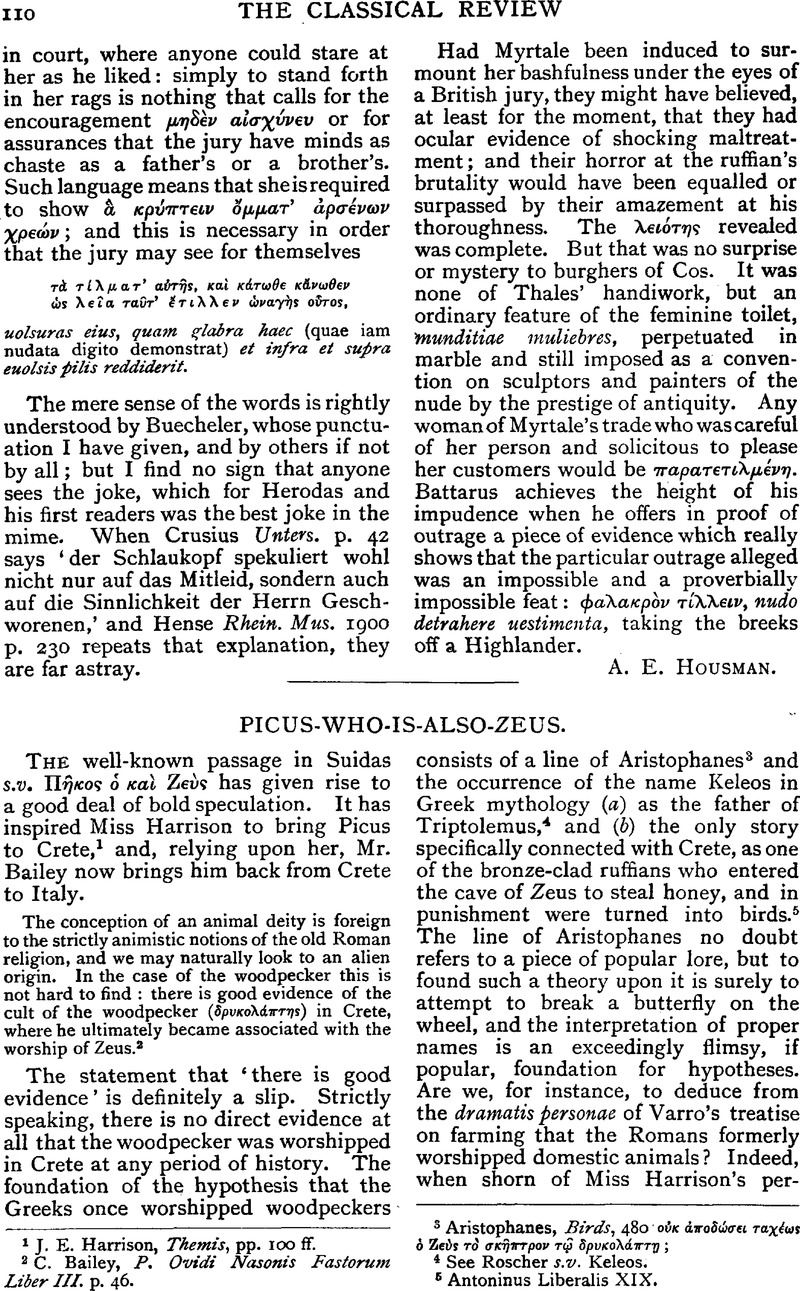Article contents
Picus-Who-is-also-Zeus
Published online by Cambridge University Press: 27 October 2009
Abstract

- Type
- Review Article
- Information
- Copyright
- Copyright © The Classical Association 1922
References
page 110 note 1 Harrison, J. E., Themis, pp. 100 ff.Google Scholar
page 110 note 2 Bailey, C., P. Ovidi Nasonis Fastorum Liber III. p. 46.Google Scholar
page 110 note 3 Aristophanes, Birds, 480 ![]() ;
;
page 110 note 4 See Roscher s.v. Keleos.
page 110 note 5 Antoninus Liberalis XIX.
page 111 note 1 Peet, , The Stone and Bronze Ages in Italy, pp. 514–515.Google Scholar
page 111 note 2 Dion. Hal. I. xiv. 5. This statement would be more helpful if we knew with any certainty what the doves at Dodona were and what they did, but we do not.
page 111 note 3 Borneo supplies examples of definite bird cults, but the actual worship of bird divinities is difficult to parallel elsewhere.
page 111 note 4 See Swainson, , Folklore of British Birds, p. 162Google Scholar; Hopf, , Thierorakel und Orakelthiere, p. 162.Google Scholar
page 111 note 5 Plutarch, , Quaest. Rom. 21.Google Scholar
page 111 note 6 So far as it goes the connexion of Picus and the obscure Picumnus with Stercutius (e.g. Augustine, De Civ. Dei, xviii. 15) seems to support this view.
page 111 note 7 Virgil, , Aeneid, VII. 45 ff.Google Scholar
page 112 note 1 Diodorus, VI., 5.
page 112 note 2 An exception is Pausanias of Damascus, Frag. 4. (Hist. Graec. Min. I. ed. Dindorf, p. 179) who tells us that Seleucus sacrificed ![]() . Here the identification with Zeus is, of course, implied, and it is used to form a link between Oriental and European history (see Note 5 below).
. Here the identification with Zeus is, of course, implied, and it is used to form a link between Oriental and European history (see Note 5 below).
page 112 note 3 Trieber, , ‘Die Idee der vier Weltreiche,’ Hermes, XXVII. (1892), pp. 321–344Google Scholar. This idea was taken over by the medieval historians. Cf. at the end of the thirteenth century Higden, Polychronicon (Rolls Series, London, 1865), II., p. 256Google Scholar; at the end of the twelfth century the second recension of the De Mirabilibus Urbis Romae (Nichols, , The Marvels of Rome, London, 1889, pp. 2 and 3Google Scholar) contains muddled reminiscences of the system.
page 112 note 4 Diodorus VI. 5; Ioannes Antiochenus, Frags. 4, 6 (F.H.G. IV. pp. 542–544); Malalas I. 19, II. 28, 34 (Migne, , Pat. Graec. XCVII. pp. 85, 95, 104)Google Scholar; Chronicon Paschale, 36–38, 44 (Migne, , Pat. Graec. XCII. pp. 143 ff.Google Scholar); Excerpta Barbari in Frick, Chronica Minora, 243, 25. Picus-Zeus is identified with Ninus, or the brother of Ninus, and is the father of Perseus, the ancestor of the Persians. Faunus, his son = Hermes Trismegistus, and forms the link with Egyptian history. Io also plays a part in this systematisation of history. Antioch was founded on the site of Iopolis, to which she fled to escape Faunus—Hermes Trismegistus.
- 1
- Cited by


